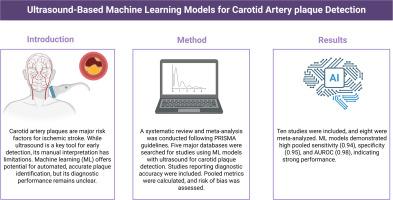Machine learning models for carotid artery plaque detection: A systematic review of ultrasound-based diagnostic performance
IF 1.8
4区 医学
Q3 NEUROSCIENCES
Journal of Stroke & Cerebrovascular Diseases
Pub Date : 2025-09-05
DOI:10.1016/j.jstrokecerebrovasdis.2025.108446
引用次数: 0
Abstract
Background
Carotid artery plaques, a hallmark of atherosclerosis, are key risk indicators for ischemic stroke, a major global health burden with 101 million cases and 6.65 million deaths in 2019. Early ultrasound detection is vital but hindered by manual analysis limitations. Machine learning (ML) offers a promising solution for automated plaque detection, yet its comparative performance is underexplored. This systematic review and meta-analysis evaluates ML models for carotid plaque detection using ultrasound.
Methods
We searched PubMed, Scopus, Embase, Web of Science, and ProQuest for studies on ML-based carotid plaque detection with ultrasound, following PRISMA guidelines. Eligible studies reported diagnostic metrics and used a reference standard. Data on study characteristics, ML models, and performance were extracted, with risk of bias assessed via PROBAST+AI. Pooled sensitivity, specificity, AUROC were calculated using STATA 18 with MIDAS and METADTA modules.
Results
Of ten studies, eight were meta-analyzed (200–19,751 patients) Best models showed a pooled sensitivity 0.94 (95% CI: 0.88–0.97), specificity 0.95 (95% CI: 0.86–0.98), AUROC 0.98 (95% CI: 0.97–0.99), and DOR 302 (95% CI: 54–1684), with high heterogeneity (I² = 90%) and no publication bias.
Conclusion
ML models show promise in carotid plaque detection, supporting potential clinical integration for stroke prevention, though high heterogeneity and potential bias highlight the need for standardized validation.

颈动脉斑块检测的机器学习模型:基于超声诊断性能的系统回顾。
背景:颈动脉斑块是动脉粥样硬化的标志,是缺血性卒中的关键风险指标,缺血性卒中是全球主要的健康负担,2019年有1.01亿例病例和665万人死亡。早期超声检测是至关重要的,但受到人工分析限制的阻碍。机器学习(ML)为自动斑块检测提供了一个有前途的解决方案,但其比较性能尚未得到充分探索。本系统综述和荟萃分析评估了超声检测颈动脉斑块的ML模型。方法:我们按照PRISMA指南,检索PubMed、Scopus、Embase、Web of Science和ProQuest,查找基于ml的颈动脉斑块超声检测的研究。符合条件的研究报告了诊断指标并使用了参考标准。提取有关研究特征、ML模型和性能的数据,并通过PROBAST+AI评估偏倚风险。使用STATA 18结合MIDAS和METADTA模块计算合并敏感性、特异性和AUROC。结果:10项研究中,8项进行了荟萃分析(200-19,751例患者)。最佳模型的总敏感性为0.94 (95% CI: 0.88-0.97),特异性为0.95 (95% CI: 0.86-0.98), AUROC为0.98 (95% CI: 0.97-0.99), DOR为302 (95% CI: 54-1684),异质性高(I² = 90%),无发表偏倚。结论:ML模型在颈动脉斑块检测中显示出希望,支持潜在的卒中预防临床整合,尽管高度异质性和潜在的偏倚突出了标准化验证的必要性。
本文章由计算机程序翻译,如有差异,请以英文原文为准。
求助全文
约1分钟内获得全文
求助全文
来源期刊

Journal of Stroke & Cerebrovascular Diseases
Medicine-Surgery
CiteScore
5.00
自引率
4.00%
发文量
583
审稿时长
62 days
期刊介绍:
The Journal of Stroke & Cerebrovascular Diseases publishes original papers on basic and clinical science related to the fields of stroke and cerebrovascular diseases. The Journal also features review articles, controversies, methods and technical notes, selected case reports and other original articles of special nature. Its editorial mission is to focus on prevention and repair of cerebrovascular disease. Clinical papers emphasize medical and surgical aspects of stroke, clinical trials and design, epidemiology, stroke care delivery systems and outcomes, imaging sciences and rehabilitation of stroke. The Journal will be of special interest to specialists involved in caring for patients with cerebrovascular disease, including neurologists, neurosurgeons and cardiologists.
 求助内容:
求助内容: 应助结果提醒方式:
应助结果提醒方式:


